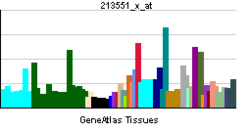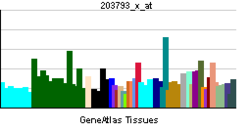- PCGF2
-
Polycomb group RING finger protein 2 is a protein that in humans is encoded by the PCGF2 gene.[1][2]
The protein encoded by this gene contains a RING finger motif and is similar to the polycomb group (PcG) gene products. PcG gene products form complexes via protein-protein interaction and maintain the transcription repression of genes involved in embryogenesis, cell cycles, and tumorigenesis. This protein was shown to act as a negative regulator of transcription and has tumor suppressor activity. The expression of this gene was detected in various tumor cells, but is limited in neural organs in normal tissues. Knockout studies in mice suggested that this protein may negatively regulate the expression of different cytokines, chemokines, and chemokine receptors, and thus plays an important role in lymphocyte differentiation and migration, as well as in immune responses.[2]
References
- ^ Ishida A, Asano H, Hasegawa M, Koseki H, Ono T, Yoshida MC, Taniguchi M, Kanno M (Aug 1993). "Cloning and chromosome mapping of the human Mel-18 gene which encodes a DNA-binding protein with a new 'RING-finger' motif". Gene 129 (2): 249–255. doi:10.1016/0378-1119(93)90275-8. PMID 8325509.
- ^ a b "Entrez Gene: PCGF2 polycomb group ring finger 2". http://www.ncbi.nlm.nih.gov/sites/entrez?Db=gene&Cmd=ShowDetailView&TermToSearch=7703.
Further reading
- Hartley JL, Temple GF, Brasch MA (2001). "DNA cloning using in vitro site-specific recombination". Genome Res. 10 (11): 1788–1795. doi:10.1101/gr.143000. PMC 310948. PMID 11076863. http://www.pubmedcentral.nih.gov/articlerender.fcgi?tool=pmcentrez&artid=310948.
- Wiemann S, Weil B, Wellenreuther R et al. (2001). "Toward a catalog of human genes and proteins: sequencing and analysis of 500 novel complete protein coding human cDNAs". Genome Res. 11 (3): 422–435. doi:10.1101/gr.GR1547R. PMC 311072. PMID 11230166. http://www.pubmedcentral.nih.gov/articlerender.fcgi?tool=pmcentrez&artid=311072.
- Kimura M, Koseki Y, Yamashita M et al. (2001). "Regulation of Th2 cell differentiation by mel-18, a mammalian polycomb group gene". Immunity 15 (2): 275–287. doi:10.1016/S1074-7613(01)00182-0. PMID 11520462.
- Miyazaki K, Inoue H, Onai N et al. (2002). "Chemokine-mediated thymopoiesis is regulated by a mammalian Polycomb group gene, mel-18". Immunol. Lett. 80 (2): 139–143. doi:10.1016/S0165-2478(01)00315-7. PMID 11750047.
- Levine SS, Weiss A, Erdjument-Bromage H et al. (2002). "The core of the polycomb repressive complex is compositionally and functionally conserved in flies and humans". Mol. Cell. Biol. 22 (17): 6070–6078. doi:10.1128/MCB.22.17.6070-6078.2002. PMC 134016. PMID 12167701. http://www.pubmedcentral.nih.gov/articlerender.fcgi?tool=pmcentrez&artid=134016.
- Suzuki M, Mizutani-Koseki Y, Fujimura Y et al. (2002). "Involvement of the Polycomb-group gene Ring1B in the specification of the anterior-posterior axis in mice". Development 129 (18): 4171–83. PMID 12183370.
- Matsuo F, Yano K, Saito H et al. (2002). "Mutation analysis of the mel-18 gene that shows decreased expression in human breast cancer cell lines". Breast Cancer 9 (1): 33–38. doi:10.1007/BF02967544. PMID 12196719.
- Strausberg RL, Feingold EA, Grouse LH et al. (2003). "Generation and initial analysis of more than 15,000 full-length human and mouse cDNA sequences". Proc. Natl. Acad. Sci. U.S.A. 99 (26): 16899–16903. doi:10.1073/pnas.242603899. PMC 139241. PMID 12477932. http://www.pubmedcentral.nih.gov/articlerender.fcgi?tool=pmcentrez&artid=139241.
- Gerhard DS, Wagner L, Feingold EA et al. (2004). "The status, quality, and expansion of the NIH full-length cDNA project: the Mammalian Gene Collection (MGC)". Genome Res. 14 (10B): 2121–2127. doi:10.1101/gr.2596504. PMC 528928. PMID 15489334. http://www.pubmedcentral.nih.gov/articlerender.fcgi?tool=pmcentrez&artid=528928.
- Wiemann S, Arlt D, Huber W et al. (2004). "From ORFeome to biology: a functional genomics pipeline". Genome Res. 14 (10B): 2136–2144. doi:10.1101/gr.2576704. PMC 528930. PMID 15489336. http://www.pubmedcentral.nih.gov/articlerender.fcgi?tool=pmcentrez&artid=528930.
- Kimura K, Wakamatsu A, Suzuki Y et al. (2006). "Diversification of transcriptional modulation: large-scale identification and characterization of putative alternative promoters of human genes". Genome Res. 16 (1): 55–65. doi:10.1101/gr.4039406. PMC 1356129. PMID 16344560. http://www.pubmedcentral.nih.gov/articlerender.fcgi?tool=pmcentrez&artid=1356129.
- Mehrle A, Rosenfelder H, Schupp I et al. (2006). "The LIFEdb database in 2006". Nucleic Acids Res. 34 (Database issue): D415–D418. doi:10.1093/nar/gkj139. PMC 1347501. PMID 16381901. http://www.pubmedcentral.nih.gov/articlerender.fcgi?tool=pmcentrez&artid=1347501.
- Silva J, García JM, Peña C et al. (2007). "Implication of polycomb members Bmi-1, Mel-18, and Hpc-2 in the regulation of p16INK4a, p14ARF, h-TERT, and c-Myc expression in primary breast carcinomas". Clin. Cancer Res. 12 (23): 6929–6936. doi:10.1158/1078-0432.CCR-06-0788. PMID 17145810.
- Guo WJ, Datta S, Band V, Dimri GP (2007). "Mel-18, a polycomb group protein, regulates cell proliferation and senescence via transcriptional repression of Bmi-1 and c-Myc oncoproteins". Mol. Biol. Cell 18 (2): 536–546. doi:10.1091/mbc.E06-05-0447. PMC 1783768. PMID 17151361. http://www.pubmedcentral.nih.gov/articlerender.fcgi?tool=pmcentrez&artid=1783768.
- Wiederschain D, Chen L, Johnson B et al. (2007). "Contribution of polycomb homologues Bmi-1 and Mel-18 to medulloblastoma pathogenesis". Mol. Cell. Biol. 27 (13): 4968–4979. doi:10.1128/MCB.02244-06. PMC 1951487. PMID 17452456. http://www.pubmedcentral.nih.gov/articlerender.fcgi?tool=pmcentrez&artid=1951487.
- Guo WJ, Zeng MS, Yadav A et al. (2007). "Mel-18 acts as a tumor suppressor by repressing Bmi-1 expression and down-regulating Akt activity in breast cancer cells". Cancer Res. 67 (11): 5083–5089. doi:10.1158/0008-5472.CAN-06-4368. PMC 2386662. PMID 17545584. http://www.pubmedcentral.nih.gov/articlerender.fcgi?tool=pmcentrez&artid=2386662.
- Szafranski K, Schindler S, Taudien S et al. (2007). "Violating the splicing rules: TG dinucleotides function as alternative 3' splice sites in U2-dependent introns". Genome biology 8 (8): R154. doi:10.1186/gb-2007-8-8-r154. PMC 2374985. PMID 17672918. http://www.pubmedcentral.nih.gov/articlerender.fcgi?tool=pmcentrez&artid=2374985.
PDB gallery Categories:- Human proteins
- Chromosome 17 gene stubs
Wikimedia Foundation. 2010.





